Calorie density: What is it and how can it help you lose weight?
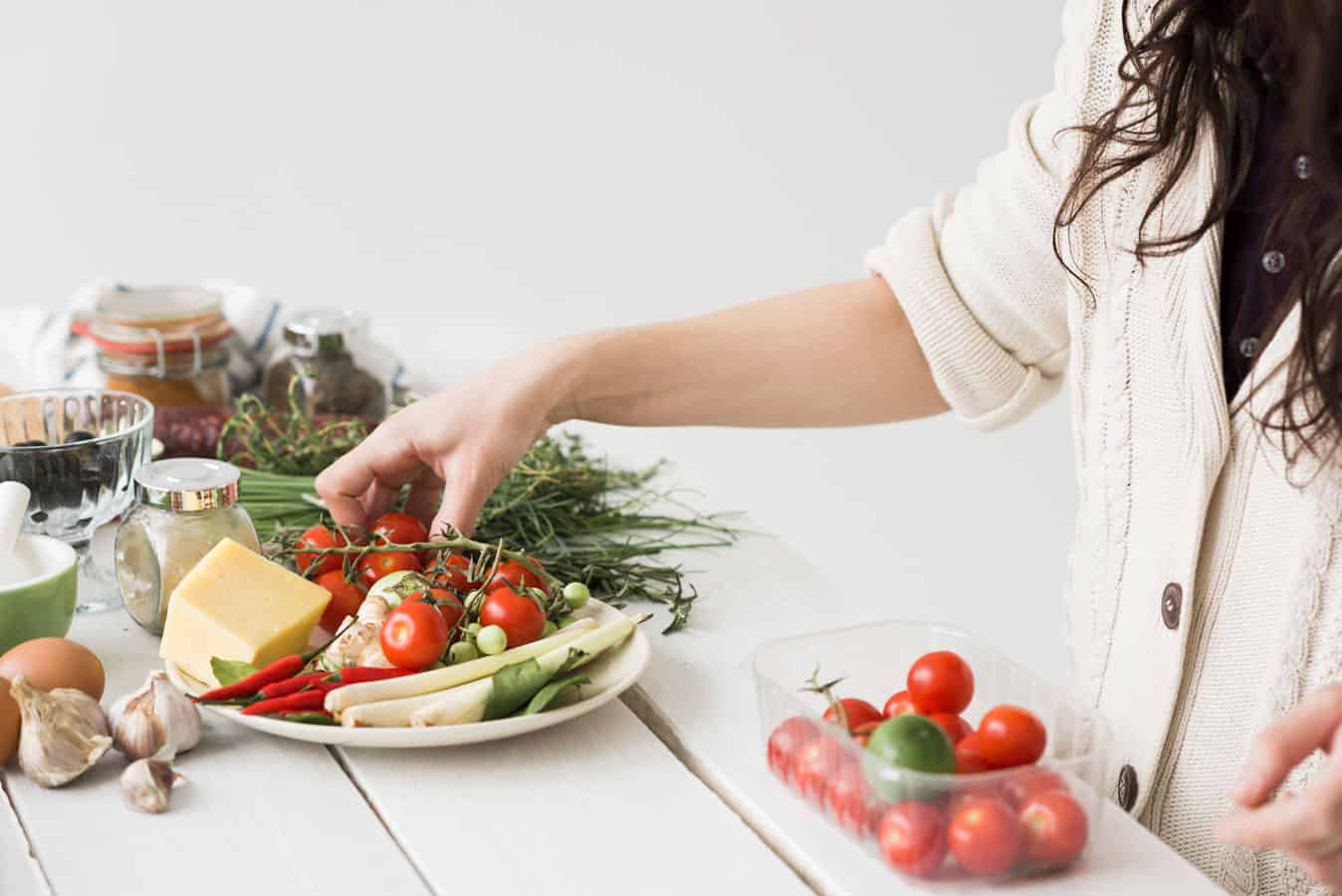
- Calorie density refers to the number of calories in a specific weight of food.
- High calorie density foods have a lot of calories concentrated in a small amount of food. Low calorie density foods contain fewer calories for the same weight.
- Calorie density is a simple and effective weight loss strategy because it helps you choose foods that keep you feeling full on fewer calories.
- Based on calorie density, Noom Weight’s three-color system guides you toward healthy and nutrient-rich whole foods that promote weight loss.
- Noom Weight’s food tracking system makes it easy to incorporate low-calorie-density options while still enjoying your favorite treats.
Theoretically, any weight loss program can help you lose weight if you consume fewer calories than you burn each day.
But that only works if you still feel full and satisfied.
If you don’t, you’ll constantly be left feeling hungry—which leads to cravings and overeating.
The solution?
Calorie density.
Calorie density allows you to overcome this weight loss challenge by choosing lower-calorie foods that are both nutritionally rewarding and satisfying.
Calorie density also gives you greater awareness.
Instead of just telling you to “eat better,” as many diets do, a calorie density approach teaches you what that actually means and how to do it.
In this article, we’ll break down what calorie density is and how it works for weight loss.
You’ll also learn how Noom’s approach to calorie density can teach you new eating habits for long-term weight loss.
Ready to make a lasting change?
A healthier you, wherever you are.
What is calorie density?
Calorie density measures the number of calories in a specific weight of the food. Foods with low caloric density (like grapes) fill you up with fewer calories than foods with high caloric density (like raisins).
The key to caloric density?
Water.
The more water a food contains, the lower its caloric density.
Low-calorie-density foods also tend to provide more fiber and nutrients, which help you feel full.
With caloric density, there are no good or bad foods.
Different foods simply have different compositions.
Walnuts, for instance, have one of the most nutritious profiles when you look at their benefits.
However, they are dense in calories, so if you don’t pay attention to your portion size, those calories add up.
How do you calculate calorie density?
It’s easy. It’s just the number of calories divided by the weight of the food, or:
Calorie Density (CD) = Calories/Weight
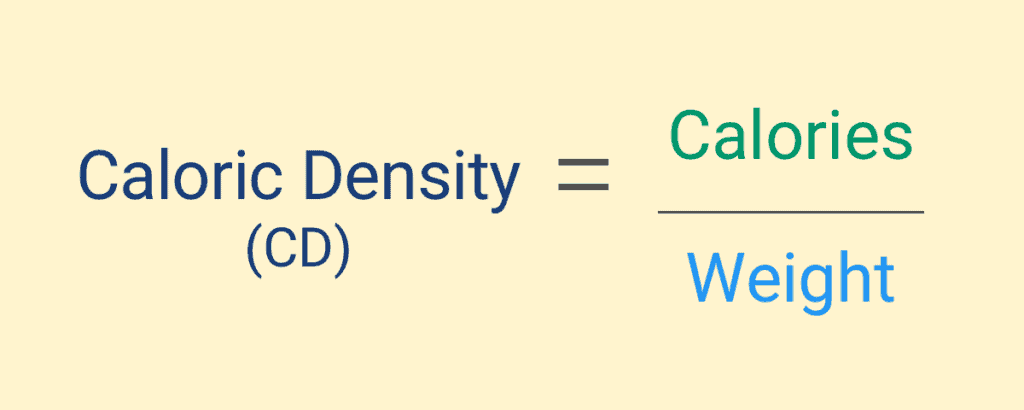
How does calorie density help you lose weight?
Imagine a quarter-pound steak and a quarter pound of cauliflower. While they weigh the same, the steak has 28 times the calories.
Here’s where it gets interesting:
If you eat the lower-calorie cauliflower, you could be just as full as if you ate the steak.
Only instead of consuming 300 calories of steak, you’ve had around 30 calories.
How?
Calorie density.
Caloric density is the key to helping you reduce your calorie intake while still eating in a way that is filling, satisfying, and nutritionally rewarding.
At Noom, we break all foods into three categories based on their calorie density:
Green, yellow, or orange.
Low-calorie-density green foods will fill you up with the least calories. Think: fruits, vegetables, and whole grains.
Yellow foods—like chicken, lean beef, or low-fat dairy—have more calories.
Orange foods, such as tortilla chips and pizza, have the highest caloric density.
But that doesn’t mean they are bad or off-limits. It just means that you’ll feel less full eating 100 calories worth of tortilla chips than if you ate 100 calories worth of cherries.
Low-calorie density foods
The following are examples of low-calorie-density foods, which Noom Weight categorizes as green.
- Fruits: berries, pineapple, watermelon, grapes, and apples
- Vegetables: cucumber, lettuce, bell peppers, carrots, zucchini, and potatoes
- Proteins: fish, shrimp, tofu, and non-fat dairy
- Non-fat dairy: Greek yogurt, cheese sticks, and cottage cheese
- Grains: whole wheat bread, quinoa, brown rice, and oats
- Snacks: unsweetened apple sauce, salsa, and pickles
- Beverages: almond, cashew, and soy milk; non-fat latte; tomato juice
High-calorie density foods
Some high-calorie-density foods—like processed foods, fried foods, and sugary treats—are obvious. Others might surprise you.
- Dried fruits: dates, banana chips, and raisins
- Proteins: bacon, 80% fat beef, fried chicken, and hot dogs
- Full-fat dairy: butter, margarine, milk, yogurt, and cheese
- Grains: white bread, hamburger buns, flour tortillas, bagels, and many kinds of cereal
- Snacks: nut butters, potato chips, pretzels, and popcorn
- Beverages: wine, margaritas, regular soda, and Frappuccinos
- Desserts: ice cream, cookies, donuts, and cupcakes
Calorie density chart
Below is a calorie density food list, broken down using our three color system:
Color Chart – Meet the Foods
Green Foods
| Fruits | Grains | Veggies | Beverages | Dairy | Condiments | Protein | Snacks |
|---|---|---|---|---|---|---|---|
| Tomatoes Cherry tomatoes Kiwi Watermelon Strawberries Oranges Grapes Raspberries Pineapple Blueberries Apples Pears Bananas Cherries Peaches Mangoes Figs |
Whole wheat: – bread – English muffins Whole grain: Quinoa |
Radish Lettuce Cucumbers Mushrooms Bell peppers Carrots Broccoli Cauliflower Asparagus Green salad Green beans Onions Peas Spinach Brussels sprouts Potatoes Sweet potatoes Zucchini Corn Spaghetti squash |
Skim milk Almond milk Cashew milk Soy milk Non-fat latte Vitamin water Unsweetened soy milk Tomato juice Beet juice Carrot juice Unsweetened apple juice |
Non-fat: – Yogurt – Greek yogurt – Cheese sticks – Cottage cheese – Cheese – Milk – Sour Cream |
Sauerkraut Salsa Hot sauces Spicy mustard Vinegars Lemon and lime juice Horseradish Fish sauce Tomato sauce |
Unsweetened – applesauce Pickles |
Shrimp Egg whites Prawns White fish fillet Crab meat Raw oyster Mahi mahi Lobster Tofu |
Yellow Foods
| Fruits | Grains | Veggies | Legumes/Seeds | Beverages | Dairy | Condiments | Proteins | Soups | Snacks |
|---|---|---|---|---|---|---|---|---|---|
| Olives Dried apricots Prunes Persimmons Canned Pineapples Avocado Plantain |
Rice – Basmati – Coconut – Yellow – Jasmine – Wild Rice noodles English muffins Spaghetti Noodles Whole wheat bagel Whole wheat tortilla Couscous Corn tortilla |
Garlic | Lentils Edamame Beans (baked, etc) Tempeh Seitan Dal Quinoa salad Chickpeas |
Diet socas Grapefruit juice Orange juice Fruit smoothie Rice milk Unsweetened cranberry juice Light beers Vodka soda or tonic |
Light/low-fat: – Cream cheese Low-fat: – Yogurt – Milk (1-2%) – Cottage cheese – Cheese |
Splenda Stevia Gravy Oyster sauce Cacao Powder Balsamic vinegar Mustard Soy sauce Pizza sauce Dried basil Sugar-free jelly |
Quail egg Crab cakes Steak Fish Sushi Tuna Eggs Turkey Chicken breast Rotisserie chicken Meatballs Ham Lean pork Lean beef Lean lamb Deli meat Duck breast Canadian bacon Canned tuna |
Tomato bisque Cream of potato Clam chowder Chili Beef chili Beef & veggie stew |
Hummus Yorkshire pudding Fruit cup Banana pancake Rice pudding Fruit cocktail Acai bowl |
Orange Foods
| Fruits | Snacks | Protein | Desserts | Beverages | Grains | Dairy | Condiments |
|---|---|---|---|---|---|---|---|
| Fruits Dates Raisins Dried cranberries |
Nut butters Nuts Tortilla chips Potato chips Crackers Popcorn Sunflower seeds Rice cakes Pretzels Protein bars Protein shakes Trail mix Flax seeds |
Bacon 80% beef Sausage Fried chicken Hot dogs Meatballs Salami Turkey bacon Chicken wings Chicken nuggets |
Sugar Chocolate milk Dark chocolate Ice cream Cookies Cake Brownies Donuts Apple pie Candy Cheesecake Cupcakes Whipped cream Cinnamon roll Pastries |
Red wine White wine Champagne Regular soda Coffee creamer Hot chocolate Vodka Margarita Apple cider Frappuccino |
White bread Biscuits Pita bread Hamburger buns Hot dog buns French bread Flour tortillas Croissants Roti Bagels Granola Dinner rolls Naan Saltines Sourdough bread Waffles Muffins Corn flakes cereal Falafels Banana bread Digestive biscuits |
Butter Margarine Full fat cheese Goat cheese (feta) Whole milk 1/2 and 1/2 Cream cheese String cheese Cottage cheese Curds Full fat yogurt |
Olive oil Ranch dressing Sour cream Mayonnaise Ketchup Jam Barbecue sauce Oil and vinegar dressing Salad dressing Pesto Coconut oil/milk Tahini Honey Maple syrup Croutons |
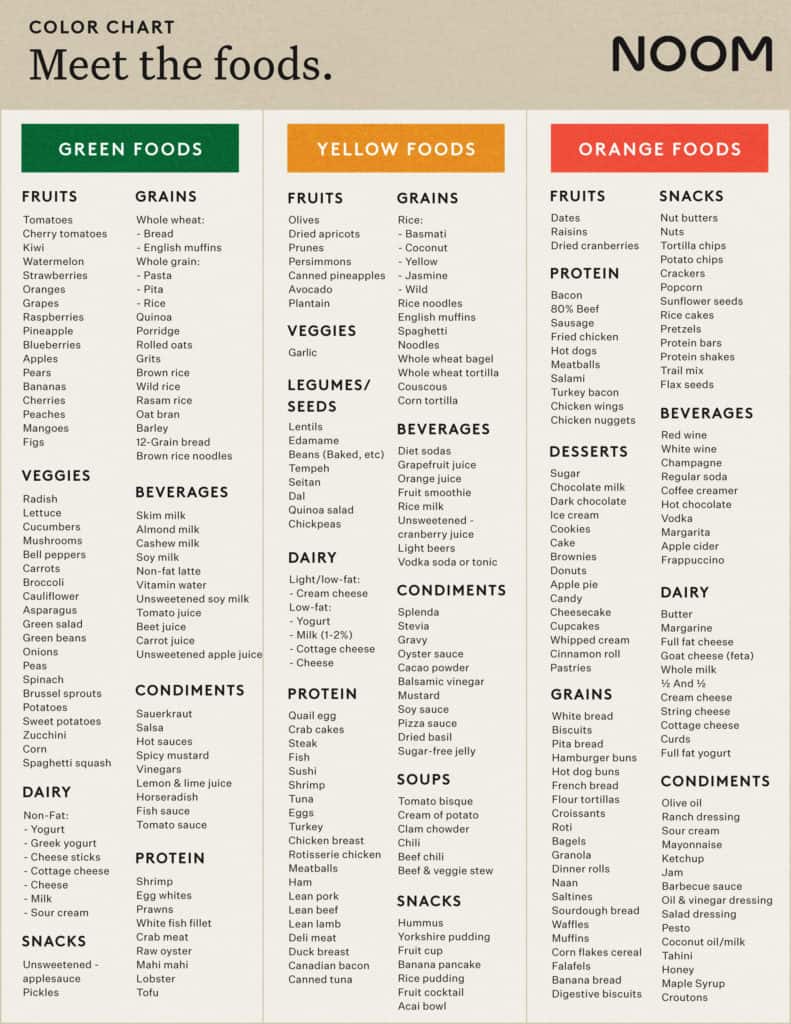
Noom’s calorie density approach to weight loss
Lose weight without feeling hungry or deprived
Calorie density is one of the main reasons Noom users say they’ve successfully lost weight on the program—and kept it off.
And Noomers who successfully hit their target weight have told us that our three-color system was key to understanding calorie density.
The color system helps them make smarter choices. It also helps remove the emotional battles and feelings of deprivation that most diets create.
First, we calculate a personalized calorie range for you. Then we recommend how many orange, yellow, and green foods you should eat daily to stay within that range.
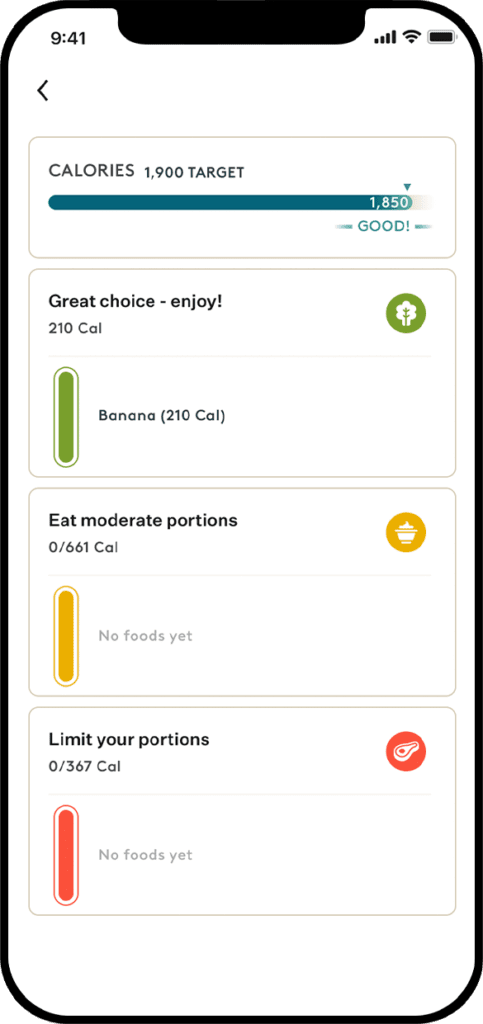
You can still enjoy your favorite (calorie-dense) orange foods—whether it’s chicken wings or garlic Naan.
We’ll provide you with guidelines for portioning those orange foods and balancing them out with more green and yellow foods to feel satisfied.
Don’t worry. We’re not saying you should “eat green” all the time. That’s not realistic.
You need a combination of green, yellow, and orange foods to get all the nutrients (and satisfaction) you need.
To build awareness, you’ll enter everything you eat into the Noom Weight app.
By tracking everything you eat, you see how the calorie density of each food affects your weight loss goals. Make gradual changes and build on those over time.
For example, you might begin by adding a serving of vegetables to every lunch and dinner. You’ll start to notice how those water-rich vegetables help fill you up.
With this system, no food is off limits. Lasagna isn’t a “slip up.”
You can simply cut back on your usual hefty portion of lasagna, pair it with a green salad, and feel satiated and full while staying within your calorie range.
We want you to enjoy all your favorite foods. With a color system based on calorie density, you can.
Learn how to add foods that are nutritionally rewarding and satisfying
Noom Weight guides you to stay within your calorie range by showing you foods that will actually satisfy you on fewer calories, not just foods you should avoid.
Maybe one of your go-to family dinners is beef-and-bean chili. Using the color system, you might modify the recipe to use half as much meat and replace it with chopped peppers and zucchini.
This small adjustment will reduce the calories in your bowl of chili by almost 50 percent while still being hearty and satisfying.
Noom’s color-coded system encourages you to examine ingrained habits, like how much oil, salad dressing, and butter you put on your food.
Even small quantities of these orange foods are high in calories.
You’ll pay closer attention to how you’re incorporating orange foods and what a proper portion size looks like.
With our food logger and extensive recipe database, Noomers find tasty alternatives to high-calorie orange foods.
Like replacing mayonnaise as a sandwich condiment with sriracha (if that’s your thing).
Or eating more soups, which are low in calories, high in water content, and can help you feel fuller for longer.
Create sustainable habits for long term weight loss
Once you internalize the three color system, you can understand how and what to eat.
You can graduate from Noom Weight and feel confident you’ll be able to maintain the new habits you’ve developed.
Noom Weight also addresses the psychological aspects of eating. After all, weight loss is about more than just understanding calorie density.
From day one, daily lessons of around 5-15 minutes prompt you to explore your mindset around the way you eat and feel about food.
These lessons help you explore what triggers you to eat when you’re not hungry and how to identify and overcome emotional eating.
You’ll gain strategies to stay motivated despite the usual fluctuations and plateaus in weight loss.
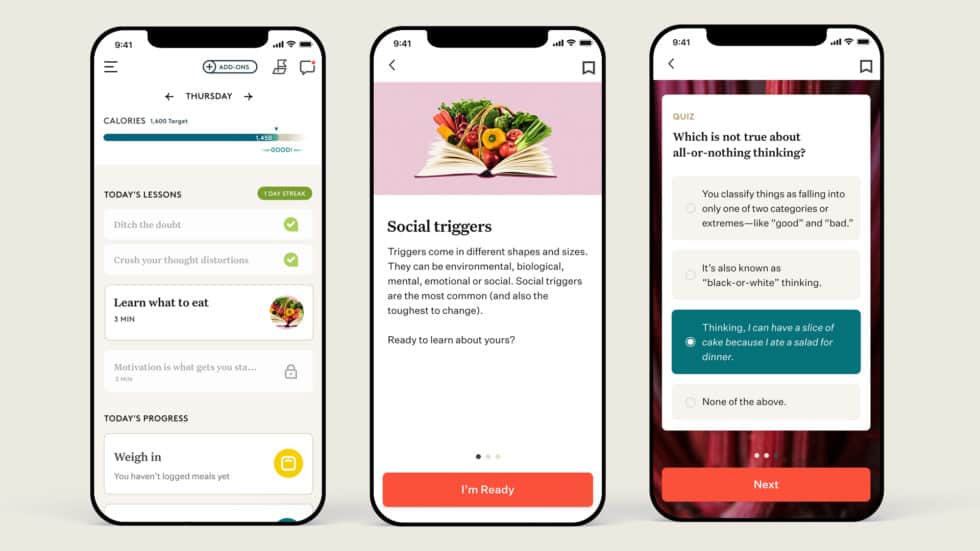
Combined with these lessons, Noom Weight’s color system helps you develop healthy eating habits you can stick with for life.
Ready to make a lasting change?
A healthier you, wherever you are.
Get started with Noom Weight
Start your weight-loss journey today for a healthier tomorrow. Sign up for a trial of Noom.

